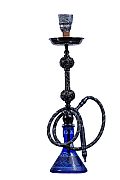- Navigating Your Midlife Crisis: Embracing New Possibilities
- City Raccoons Showing Signs of Domestication
- Mapping the Exposome: Science Broadens Focus to Environmental Disease Triggers
- One Week Less on Social Media Linked to Better Mental Health
- Your Brain Changes in Stages as You Age, Study Finds
- Some Suicide Victims Show No Typical Warning Signs, Study Finds
- ByHeart Formula Faces Lawsuits After Babies Sickened With Botulism
- Switch to Vegan Diet Could Cut Your Greenhouse Gas Emissions in Half
- Regular Bedtime Does Wonders for Blood Pressure
- Dining Alone Could Mean Worse Nutrition for Seniors
Hookah Use May Make Cigarette Habit More Likely in Teens


Exotic hookah water pipes are all the rage among teens and young adults, but a new study suggests they could be a “gateway” device to cigarette smoking.
The study found a similar effect for young people who use snus — a type of moist chewing tobacco that is popular in Sweden.
“Yet, water pipe tobacco remains largely unregulated by the FDA [U.S. Food and Drug Administration], and snus is less regulated than other smokeless tobacco,” a team led by Samir Soneji, of Dartmouth College School of Medicine in Lebanon, N.H., wrote in the Dec. 8 online edition of the journal JAMA Pediatrics.
One expert agreed that more regulation may be needed.
“The wide variety of flavors, low prices, and appealing packaging of these products attract young people, which as this study indicates can lead to cigarette smoking,” said Patricia Folan, director of the Center for Tobacco Control at North Shore-LIJ Health System in Great Neck, N.Y.
The results of the new study “may help the FDA develop effective regulations to prevent the sale and use of these products to youth,” she added.
In the study, Soneji’s team looked at data on nearly 1,050 nonsmokers aged 15 to 23. Of those, about 7 percent said they had used hookahs and about 2 percent had used snus.
After two years, 39 percent of those who had smoked hookahs had also started smoking cigarettes, compared with about 20 percent of those who had not used the water pipes, the study found.
When came to people who’d tried snus, 55 percent had started smoking cigarettes, compared with about 20 percent of those who had not used snus.
“This study provides evidence that using these alternative products increases the likelihood of cigarette smoking, leading to the hazardous consequences of smoking-related disease and disability,” Folan said.
Another expert believes nicotine is the common, addictive element at play in all these tobacco-based products.
“Nicotine remains one of the most addicting substances and teens are especially vulnerable to its addiction,” said Dr. Mary O’Sullivan, director of the Smoking Cessation Program at Mount Sinai St. Luke’s Hospital in New York City. “Those youth who are especially susceptible to nicotine addiction, by their genetic or sociological profile, with fairly brief exposure to nicotine will risk developing a potentially permanent addiction,” she explained.
O’Sullivan added that the new findings are “all the more timely, since the FDA will shortly be considering a Swedish tobacco company’s petition to soften the warning labels on its smokeless chewing tobacco.”
More information
The U.S. Centers for Disease Control and Prevention has more about youth and tobacco.
Source: HealthDay
Copyright © 2025 HealthDay. All rights reserved.










